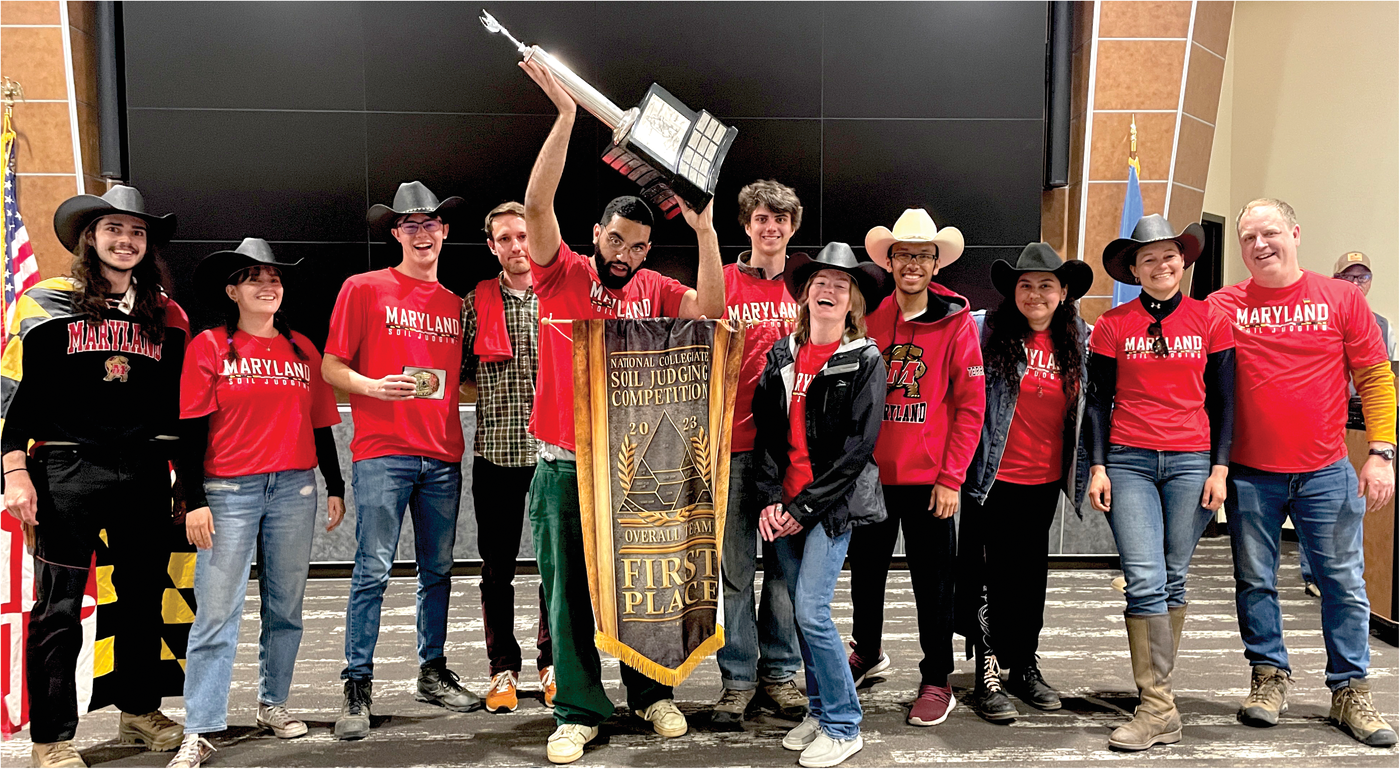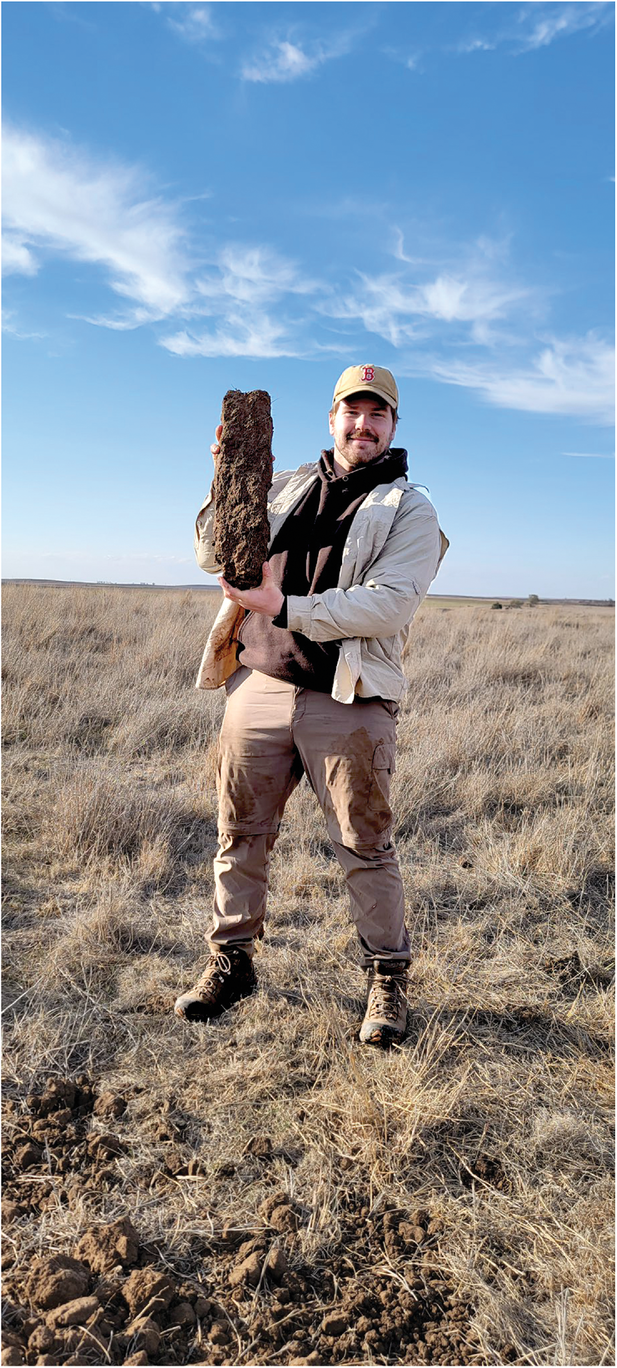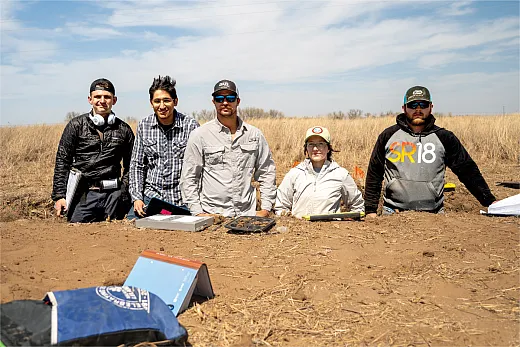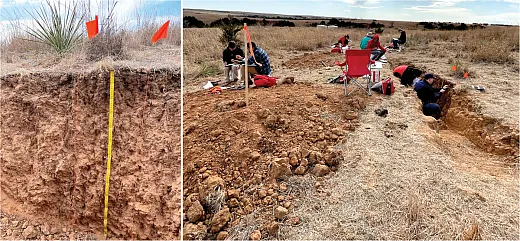Soil-Judging Roundup in the Wild West
University of Maryland Lassos a Win at the 2023 National Soils Contest in Oklahoma


The University of Maryland Terrapins took first place in the 2023 National Collegiate Soils Contest, which was sponsored by SSSA and hosted by Oklahoma State University on March 26 to 31 in Woodward, OK. The contest area was in a region of the country highly affected by the 1930’s Dust Bowl with predominately Mollisols, Alfisols, and Inceptisols. Predominate epipedons were ochric and mollic with subsurface horizons of cambic, argillic, and some calcics.
Four individuals from each school competed for the individual portion of the competition, which comprised of three soil pits; one group pit was judged by all members of each competing school. Twenty‐three schools from the U.S. competed in this year’s contest. Students were given four practice days with described soil pits and road cuts to get acquainted with the buried horizons, fine sands, gypsum, and secondary carbonate accumulations found in northwestern Oklahoma.
Soil judging (if offered at an institution) provides undergraduate students with intensive pedology training that they are then tested on at regional contests in the fall; and if they qualify, students also complete at the national contest held each spring. Students make a soil morphological description (along with taking into account the general landscape of location) and then apply their pedological knowledge to determine water‐holding capacity, soil erosion potential, and land‐use decisions made by consultants such as suitability for basements, septics, or roads/streets.
Contest Results and Area
Following closely behind the University of Maryland (first) for overall schools were: California Polytechnic State University (Cal Poly) San Luis Obispo (who, with their striking brown corduroy jackets, finished second), the University of Rhode Island (third), the University of Nebraska at Lincoln (who, in addition to placing fourth, were line‐dancing pros!), and the University of Wisconsin at Platteville (fifth). Group judging resulted in Tarleton State University winning first place followed by the University of Arkansas (second), Colorado State University (third), University of Minnesota–Twin Cities (fourth), and Cal Poly San Luis Obispo (fifth). Many soil judgers at the group pit got to observe real cowboys rounding up cattle!
Braden Fleming from the University of Rhode Island placed first in the individual contest. Isaac Nollen from University of Wisconsin at Platteville took second with Will Hatcher (University of Tennessee–Knoxville) in third place, Alex Quigley (University of Maryland) in fourth place, and Lauren Morris (Cal Poly San Luis Obispo) taking fifth place.

The contest area was stricken by severe drought (5–6 inches of rain for the past eight months), which made identifying floodplains tricky for schools from more temperate areas of the country. Since the contest area was previously affected by the Dust Bowl and is within the broad rain shadow of the Rocky Mountains with eolian sand deposits, shifting sand landscapes such as dunes, sand sheets, and interdunes were present and identified by students. The landscape was mostly comprised of broad rangelands with some evergreen trees/shrubs. Floodplains could commonly be identified by the presence of woody, deciduous vegetation. Conditions were very windy (wind gusts commonly 25 to 35 mph) with some students purchasing goggles to prevent sand from getting into their eyes during practice and the contest. Judgers truly experienced Oklahoma “where the wind comes sweeping down the plains!” (Oklahoma! musical song reference).

Career‐Shaping Experiences
“There is nothing better than getting the opportunity to learn about new soils and gain field experience that we can directly relate to our future careers,” says University of Maryland senior Nikki Zimmerman. “This team has made a huge difference in my senior year, and I’m so proud to be a part of it.” The University of Maryland has been involved in soil judging since 1961; this year’s win was particularly impressive given eight of the nine soil judgers were first‐year judgers.
“Soil judging provides students with unique opportunities to see soil in different places across the country,” says this year’s top individual, Braden Fleming of the University of Rhode Island. “It’s these experiences that help shape our careers, and I am grateful to have been a part of it.”
Since only four team members from each school can compete in the individual portion (this does not apply to group pit judging), a contest for alternates is commonly held to provide all students with the contest experience. The alternates contest comprised of two pits (run by Dr. Patrick Drohan of Penn State University with grading coordinated by Drs. Judy Turk and Rebecca Young of the University of Nebraska–Lincoln and Dr. Amber Anderson from Iowa State University). This year, recognition awards were given to the top five alternate finishers: Liz Eroshenko (first, Virginia Tech), Jackson Metz (second, Purdue), Gregor Willms (third, University of Wisconsin at Stevens Point), and Alex Sirovy and Alena Wallin (fourth and fifth, respectively, University of Minnesota–Twin Cities).
The 2024 National Collegiate Soils Contest will be hosted by Iowa State University (led by Dr. Amber Anderson). Many thanks to Dr. Jason Warren and Janelle Malone from Oklahoma State University (the contest host) and all those who assisted in making this contest possible; it was a great event in an interesting location that many of students had never experienced before. “You’re doing fine Oklahoma… Oklahoma, OK!” (Oklahoma! musical song reference)
Text © . The authors. CC BY-NC-ND 4.0. Except where otherwise noted, images are subject to copyright. Any reuse without express permission from the copyright owner is prohibited.











